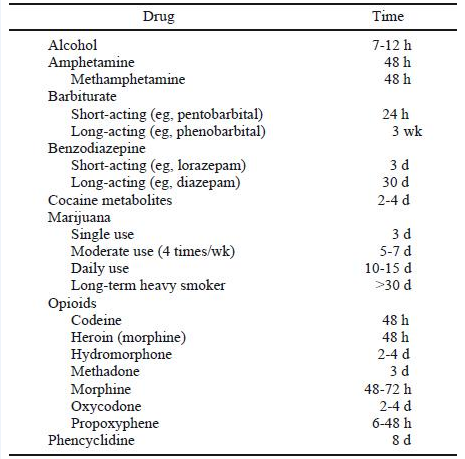Substances that can be detected by US testing
- Amphetamine type compounds – e.g. ice, speed and ecstasy
- Benzodiazepines – e.g. valium and diazepam
- Cannabis metabolites – e.g. marijuana
- Cocaine metabolites
- Opiates – e.g. heroin, codeine, and morphine
- Buprenorphine
- Methadone metabolite
- Synthetic cannabis
When planning drug testing for parents, consider the frequency and duration of testing, and the type of testing (random or scheduled testing or a combination of both). You may seek advice from drug testing providers or drug specialists to determine testing schedules.
Frequency of testing
Refer to the table below when scheduling UA testing and consider the time in which drugs can be detected. The table provides a general indication of how long drugs can be identified in UA testing.
If cannabis is the drug being misused, less frequent testing is appropriate given the length of time the drug stays in the body.
If the types of drugs being misused are unknown, UA testing two-three times a week may be suitable. 
Duration of testing
Take into account the history of the parent's drug misuse when considering the duration of planned drug testing. It may be appropriate to have either:
- one-off testing (that could be repeated), or
- a schedule of testing.
One-off testing may be useful to manage a parent’s denied drug misuse. A schedule of testing over a timeframe of one to three months may be useful to demonstrate reduced or increased use of drugs.
Random or scheduled testing
Random UA testing is preferred over scheduled tests because it minimises the potential for parent manipulation. You should notify the parent on the morning of the drug test, to reduce opportunities for parents to manipulate the results.
Parents not attending a drug test
Where there is no legitimate reason for a parent not attending drug testing, record the result as a positive due to non-compliance. If the parent does not attend for drug testing when required, ask them to provide a UA test the next day, unless there are legitimate circumstances, such as illness or bereavement.
Reviewing the use of urinalysis testing
Regularly assess whether UA testing is still required to provide information on type, level and pattern of drug use. Review the use of testing when:
- positive results occur over a period and there is little evidence of behaviour change and/or engagement with AOD services, or
- negative results occur over a period; this may show evidence of behaviour change and less frequent testing may be more appropriate.
Team leaders should review their teams' use of testing and align with the Drug Testing Policy and this entry.
Hair testing
Although UA testing is the preferred method, you can consider using hair drug testing if it costs less than UA testing and/or the information required in relation to type, level and pattern of drug use is only able to be ascertained through this method.
Hair drug testing can provide a long term picture (pattern) of drug misuse in a one-off testing process. You should contact the hair drug testing provider to discuss the types of drugs that can be detected, limitations in testing and obtain a quote on the total cost. The cost is determined by the type and level of analysis required and can be very expensive. the quote must be approved by a TL before this type of testing is done. Refer to the Drug Testing Guide for further information.

